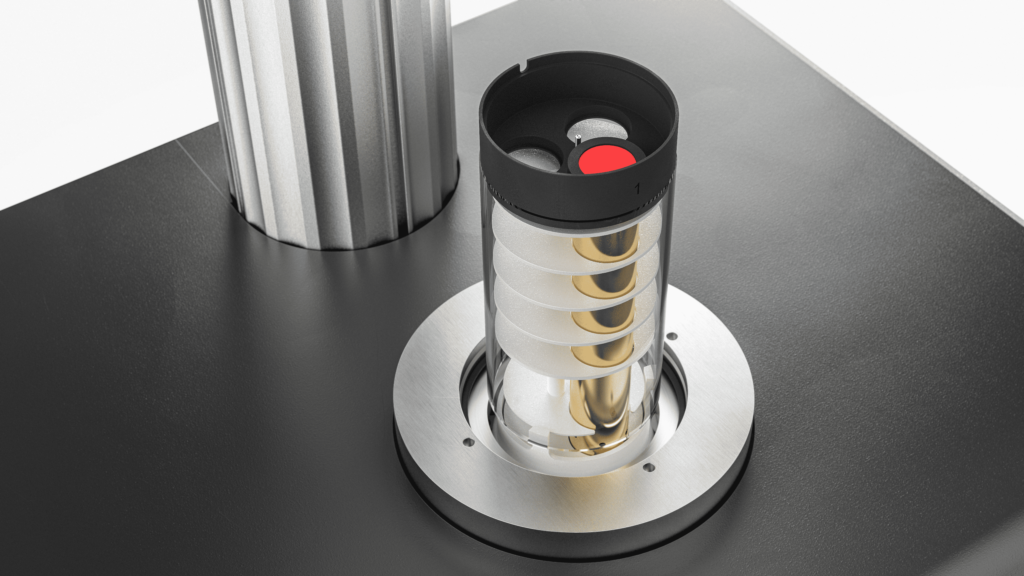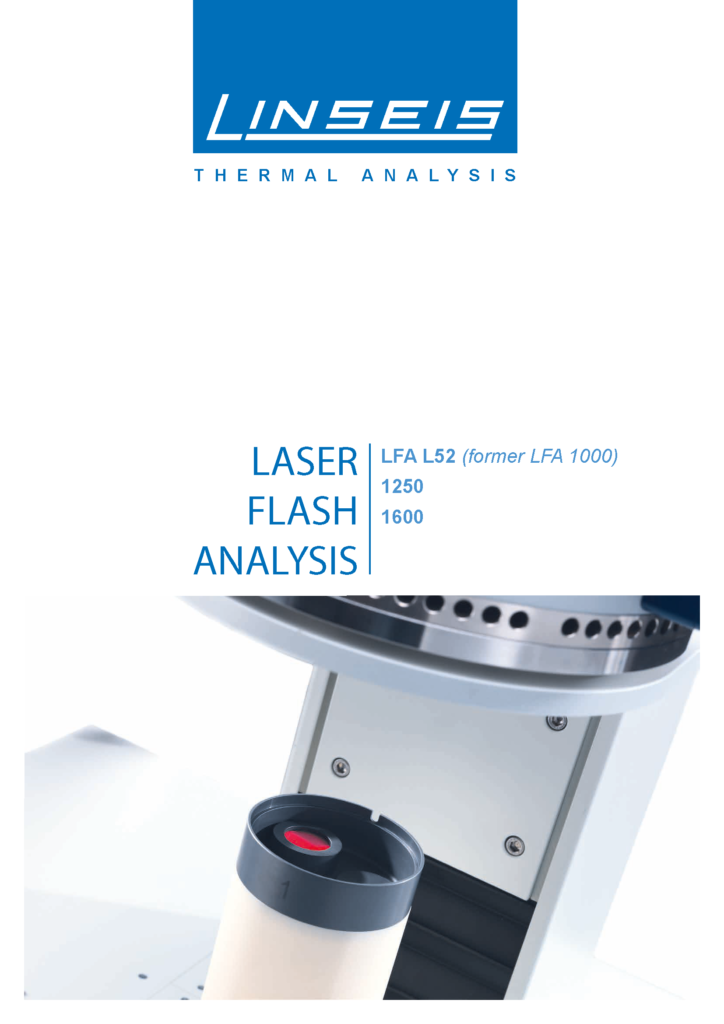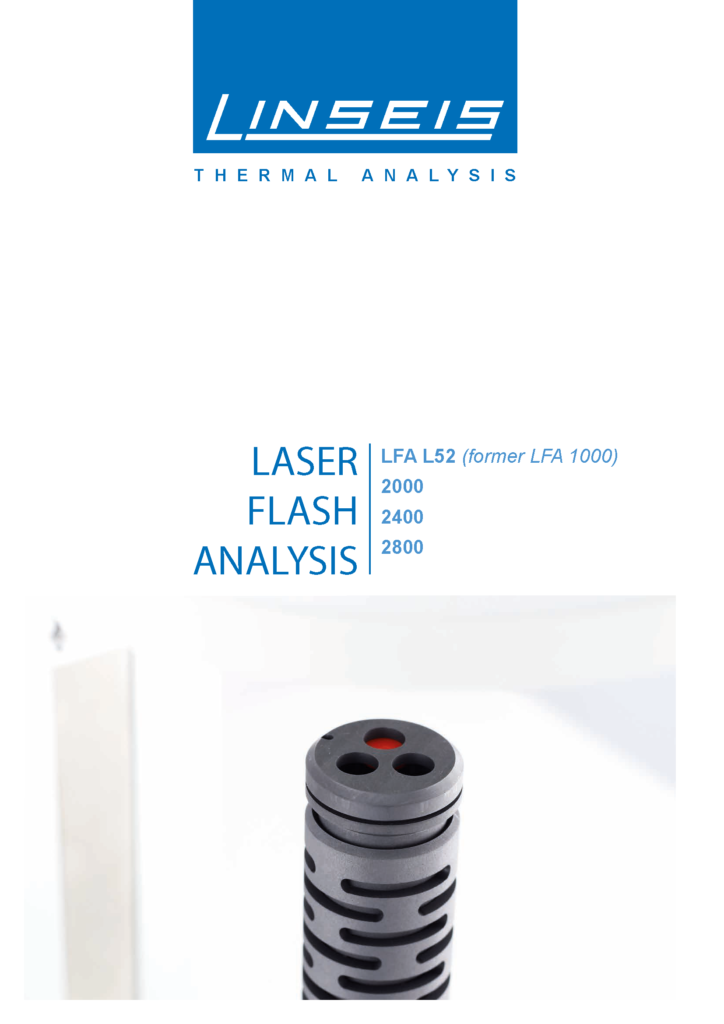Description
To the point
Information about the thermophysical properties of materials and the optimization of heat flow in end products is becoming increasingly important in many industrial applications. In recent decades, the flash method has become the most commonly used technique for determining the thermal diffusivity and thermal conductivity of solids, powders and liquids.
The LINSEIS LFA L52 LaserFlash Analyzer is an effective method for measuring thermal conductivity, thermal diffusivity and specific heat with simultaneous measurement of up to three, six or 18 samples. Various furnaces allow measurement in a temperature range from -125°C to 2800°C. A turntable for a second furnace is available as an option.
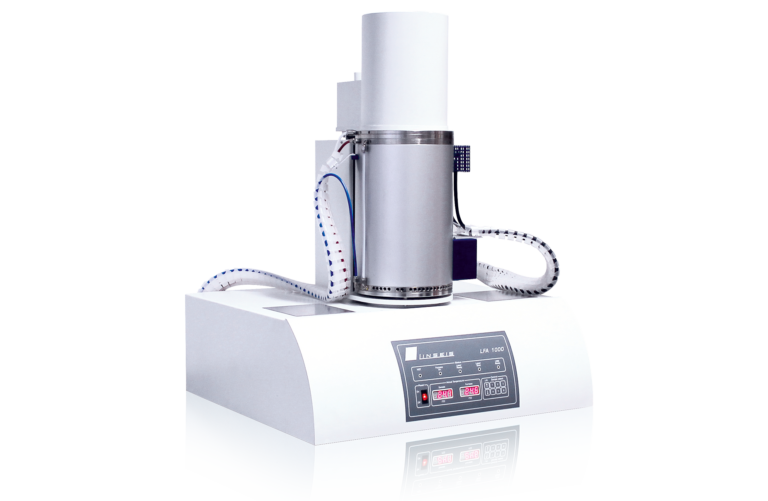
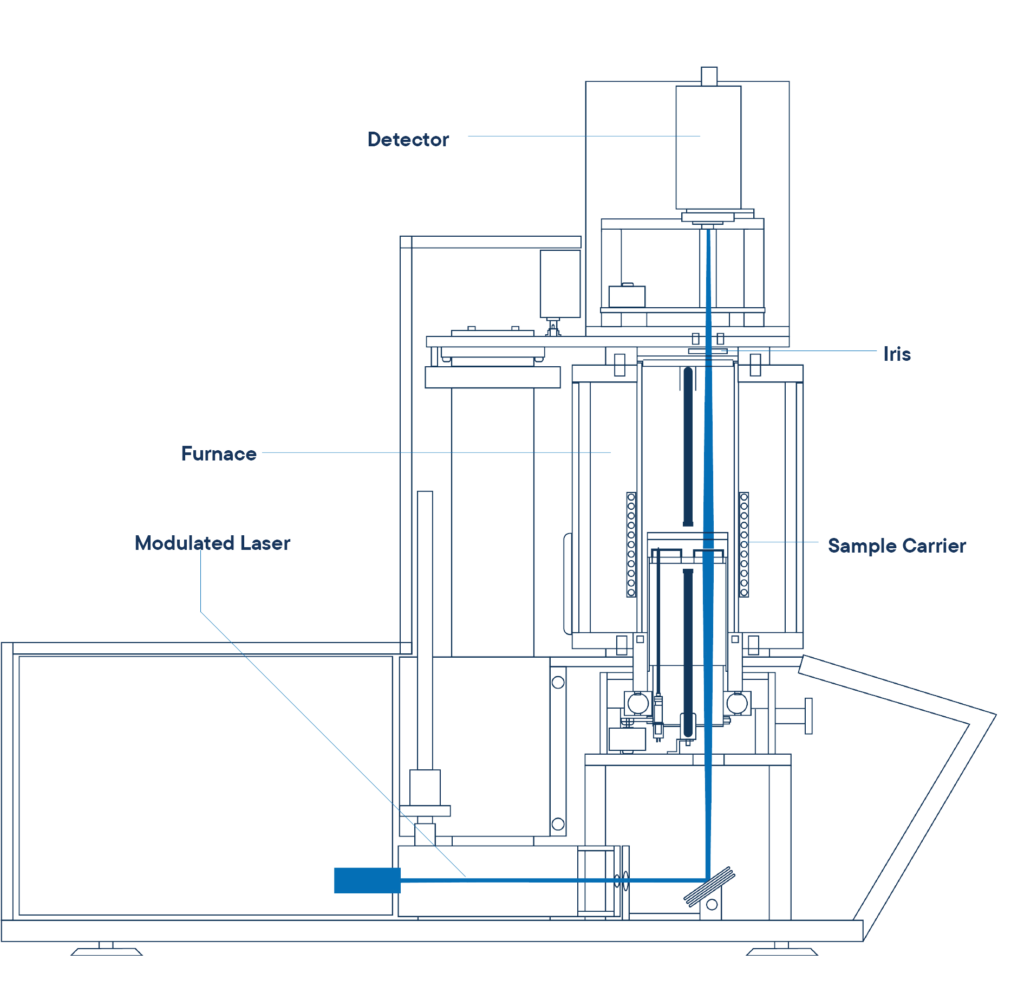
The LaserFlash Analyzer uses a modulated laser beam that is focused on the bottom side of the sample to bring in a controlled amount of heat energy. The sample absorbs the laser puls and heat is transferred through the sample layer. At the top side of the sample there is a focus lense, an iris and a diode based IR-detector to monitor the amount of transferred heat and the transition time of the heat wave. By applying literature known models on the detector readout, the thermal diffusivity and thermal conductivity of the sample can be calculated depending on the sample temperature.
Unique Features
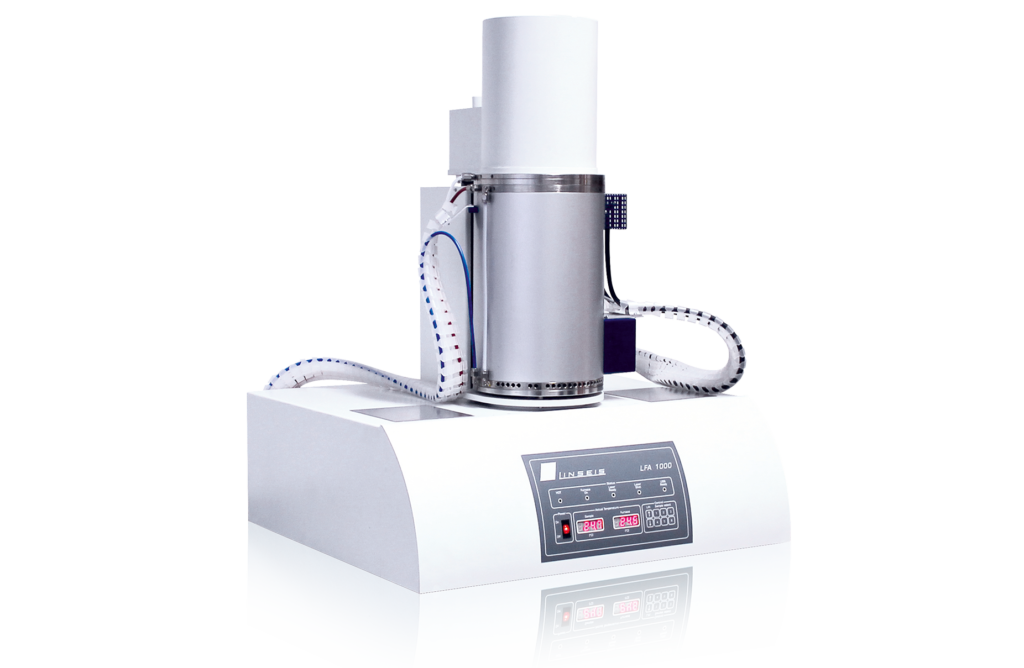
Wide temperature range:
-125°C to 2800°C
High precision and repeatability
of measurements
Modular design for
flexible customization
Fast measuring times thanks
to advanced IR-detector technology
User-friendly software for
comprehensive data analysis
Compatibility with different sample
geometries and materials
Questions? We're just a call away!
+1 (609) 223 2070
+49 (0) 9287/880 0
Our service is available Monday to
Thursday from 8-16 o’clock
and Friday from 8-12 o’clock.
Wir sind für Sie da!
Specifications
Hard Facts
MODEL | LFA L52 |
|---|---|
| Temperature range: | -125 °C/ -100°C up to 500°C RT up to 1250°C RT up to 1600°C |
| Pulse source: | Nd:YAG laser, user replaceable |
| Measurement of temperature rise: | Contactless via IR (InSb or MCT) detector |
| Measuring range thermal diffusivity: | 0,01 mm2/s up to 2000 mm2/s |
| Measuring range thermal conductivity: | 0.1 W/mK up to 3500 W/mK |
| Sample size: | ∅ 6, 10, 12.7 ... 25.4 mm Square samples 10×10 or 20×20 mm |
| Sample thickness: | 0.1 mm ... 6 mm |
| Number of possible samples: | Sample robot for up to 3, 6 or 18 samples |
| Sample holder: | metal/SiC/graphite |
| Atmosphere: | inert or reducing |
| Data acquisition: | 2 MHz |
| Interface: | USB |
| Heating rate: | 0.01 - 50 °C/min* |
| *Depending on the selected furnace | |
MODEL | LFA L52 2000 |
|---|---|
| Temperature range: | RT up to 2800°C |
| Pulse source: | Nd:YAG laser 25 J/pulse |
| Measurement of temperature rise: | Contactless via IR (InSb or MCT) detector |
| Measuring range thermal diffusivity: | 0.01 mm2/s ... 2000 mm2/s |
| Measuring range thermal conductivity: | 0.1 W/m*K ... 4000 W/m*K |
| Sample size: | ∅ 6, 10, 12.7 ... 25.4 mm |
| Sample thickness: | 0.1 mm ... 6 mm |
| Number of possible samples: | Sample robot for up to 3 samples |
| Sample holder: | metal/SiC/graphite |
| Atmosphere: | inert or reducing (recommended) |
| Data acquisition: | 2 MHz |
| Interface: | USB |
| Heating rate: | 0.01 - 100 °C/min* |
| *Depending on the selected furnace | |
Software
Making values visible and comparable
All thermo analytical devices of LINSEIS are PC controlled, the individual software modules exclusively run under Microsoft® Windows® operating systems. The complete software consists of 3 modules: temperature control, data acquisition and data evaluation. The Linseis 32 – bit software encounters all essential features for measurement preparation, execution and evaluation, just like with other thermo analytical experiments.
LFA Features
- Precise pulse length correction, pulse mapping
- Heat-loss corrections
- Analysis of 2- or 3-layers systems
- Dusza model for simultaneous finite pulse and heat loss correction
- Wizard for selection of the perfect evaluation model
- Specific heat determination
- Contact resistance determination in multi-layer systems
Evaluation Software
- Automatic or manual input of related measurement data (density, specific heat)
- Model wizard for selection of the appropriate model
- Finite pulse correction
- Heat loss correction
- Multilayer model
- Determination of contact resistance
- Cp (Specific Heat) determination by comparative method
Measurement Software
- Easy and user-friendly data input for temperature segments, gases etc.
- Controllable sample robot
- Software automatically displays corrected measurements after the energy pulse
- Fully automated measurement procedure for multi sample measurements
Applications
Application example: Thermal diffusivity of glass ceramic with LFA L52
Pyroceram, a glass ceramic trademark of Corning used as a standard material in various applications, has been measured using the LFA L52 to show the reproducibility of thermal diffusivity values. In total 18 measurements were performed with 18 samples that were cut out of one bulk block. Each sample was measured separately and the result shows a spread in the result that is in a range of +/- 1 % in a temperature range up to 1250°C.
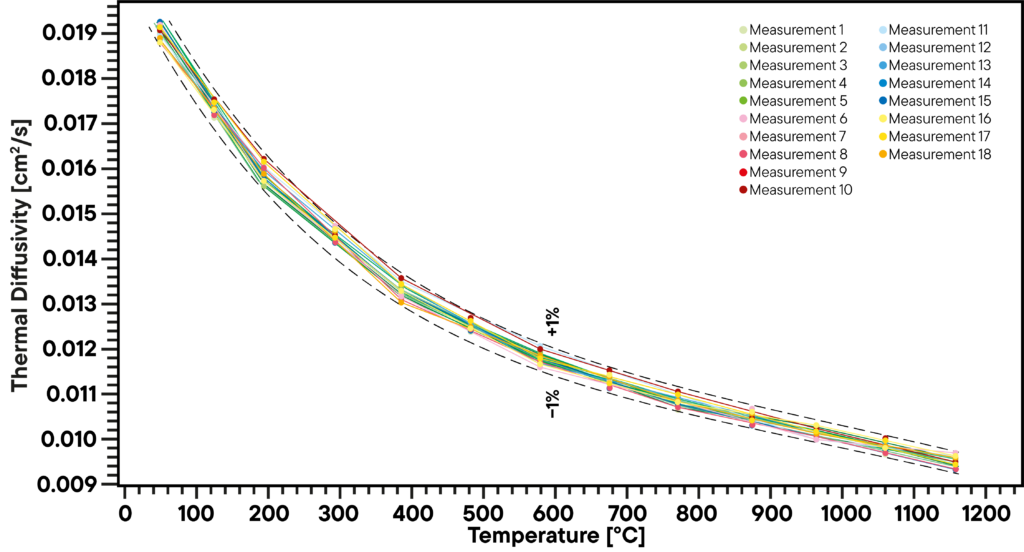
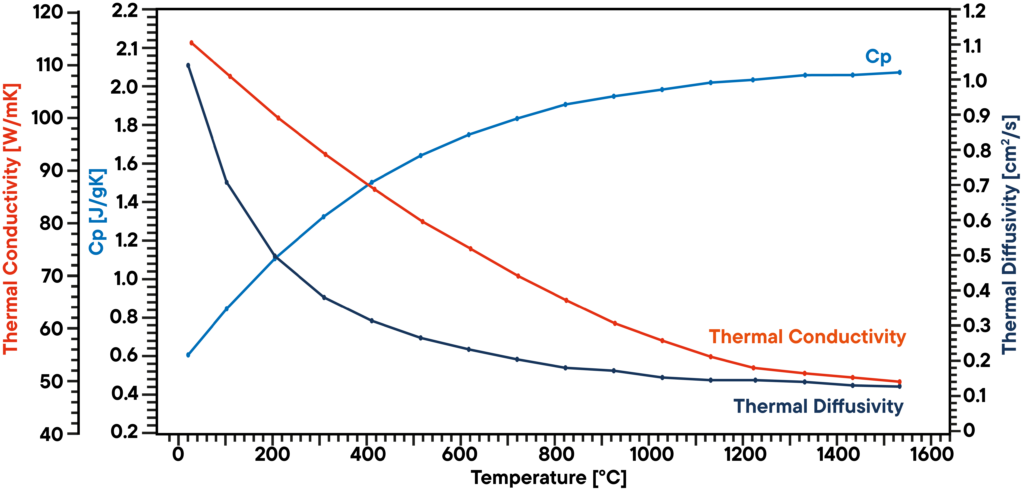
Application example: Thermal conductivity of graphite with LFA L52
A graphite sample has been investigated using the LFA L52. Thermal diffusivity has been determined directly at several temperature between RT and 1600°C. Specific heat capacity has been determined using a known graphite standard in a second sample position as a reference in the same measurement. The product out of diffusivity, specific heat and density gives the corresponding thermal conductivity. The result shows a linear decreasing thermal conductivity which is typical and a thermal diffusivity that is showing a plateau above 500°C. The Cp is slightly increasing over temperature.
Application example: Influence of sample thickness on thermal conductivity accuracy of LFA L52
The accuracy of thermal conductivity values depending on sample thickness was investigated using a silver standard. To get an idea which sample thickness is ideal for the laser flash method, silver samples with different thickness were measured at room temperature. The thermal conductivity was calculated out of thermal diffusivity, density and heat capacity. The scheme shows that the accuracy (deviation from literature value) grows exponential the smaller the diameter gets. The limit for an accurate value is around 200 micrometers. Below that “barrier” the values are dramatically different. However this is not only because of the limitations of the method, but also due to the fact that thin layers show different behavior like bulk materials what can be investigated using the THIN FILM LFA or other thin film techniques.
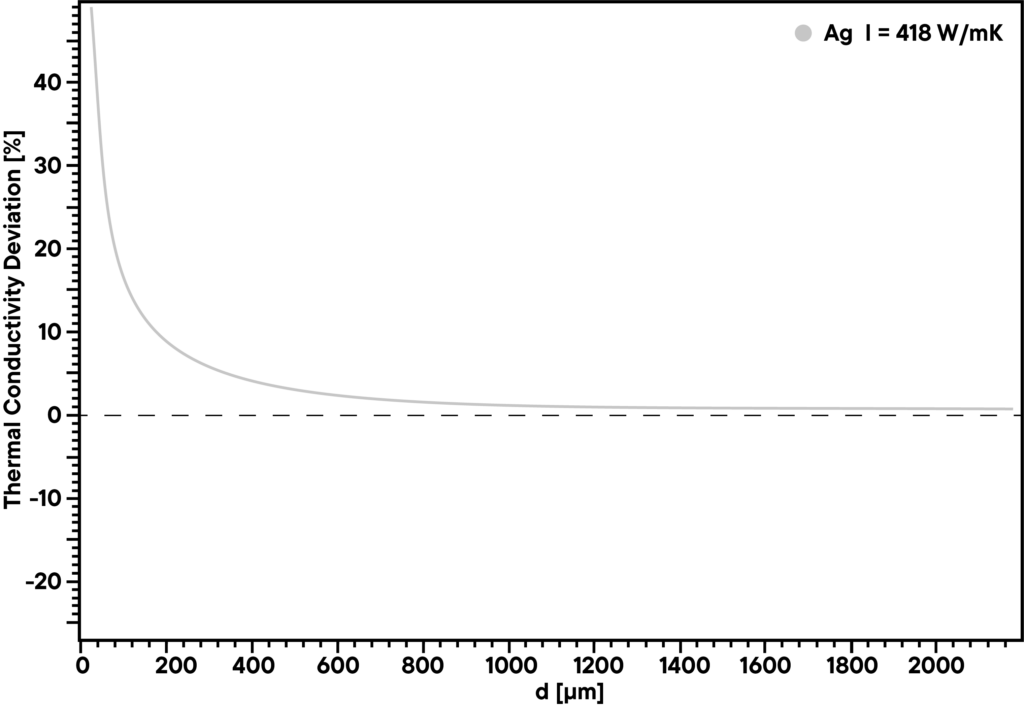
well informed
